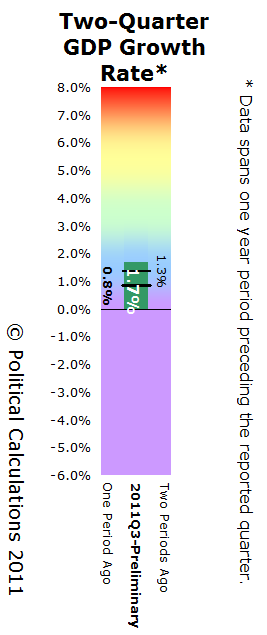The U.S. Bureau of Economic Analysis has revised its initial estimate of GDP in the third quarter of GDP downward. We've adjusted our GDP forecast for the fourth quarter of 2011 accordingly.
Using our preferred Modified Limo method for forecasting GDP, we anticipate that U.S. GDP for the fourth quarter of 2011 has roughly a 68% probability of being between $13,252.9 billion and $13,533.7 billion in terms of constant 2005 U.S. dollars. It has a 99.7% probability of falling between $12,972.5 billion and $13,814.5 billion. The midpoint for our forecast range for GDP in 2011-Q4 using the data available to us now is $13,393.3 billion, in terms of constant 2005 U.S. dollars.

Looking at where U.S. GDP for the third quarter of 2011 has now been adjusted, we note that the midpoint of our forecast range for this quarter is now within 0.28% of where the BEA has revised its GDP estimate.
There will be one more scheduled revision of GDP data for this quarter. We will update our forecast for 2011-Q4 GDP accordingly when this third estimate is released.
Looking backward, our GDP temperature gauges show how the United States' economy has performed over the past three to four quarters with respect to its historical performance since 1980.

|

|
In these charts, the temperature spectrum runs from the "cold" purple range, indicating recessionary conditions, through the "cool" blue range, the "comfortable" green range, which indicates solid economic growth, and on through the more "heated" yellow range on up to the "overheated" red range, which are self-explanatory.
Of these two charts, the Two-Quarter GDP Temperature Gauge provides the better indication of how the U.S. economy has performed over time. We present the One-Quarter GDP Temperature Gauge since its data corresponds to the annualized GDP growth rates reported for each quarter in the media.
Here, the Two-Quarter GDP Temperature Gauge, which covers the two-quarter long intervals of 2010-Q3 through 2011-Q1 (two periods ago), 2010-Q4 through 2011-Q2 (one period ago) and 2011-Q1 through 2011-Q3 (the most recent period) reveals that the U.S. economy over the past year has ranged from recessionary levels, as indicated by the very "cold" purple color to near-recessionary levels, as indicated by the "cool" blue color, which are characterized by lackluster economic growth.
Since the U.S. economy's performance is largely driven by inertia, we anticipate that this lackluster performance will continue well into 2012.
Labels: gdp, gdp forecast
Welcome to the blogosphere's toolchest! Here, unlike other blogs dedicated to analyzing current events, we create easy-to-use, simple tools to do the math related to them so you can get in on the action too! If you would like to learn more about these tools, or if you would like to contribute ideas to develop for this blog, please e-mail us at:
ironman at politicalcalculations
Thanks in advance!
Closing values for previous trading day.
This site is primarily powered by:
CSS Validation
RSS Site Feed
JavaScript
The tools on this site are built using JavaScript. If you would like to learn more, one of the best free resources on the web is available at W3Schools.com.